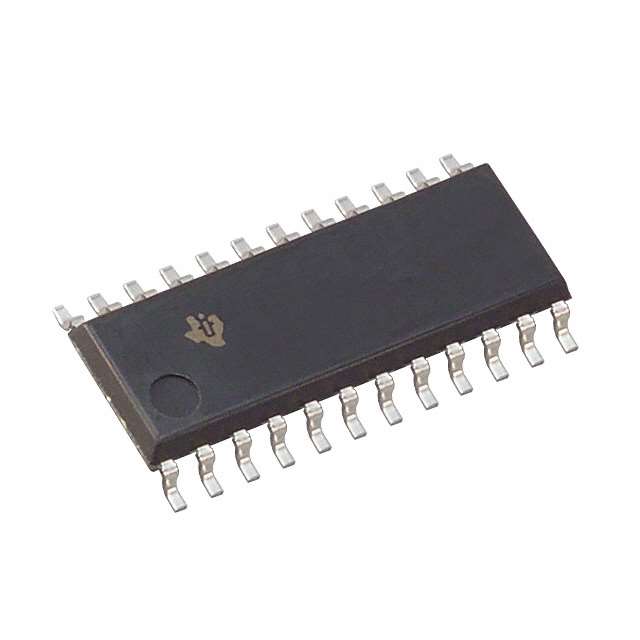Xem thông số kỹ thuật để biết chi tiết sản phẩm.

SN74LVC863ANSRE4
Product Overview
- Category: Integrated Circuit
- Use: Logic Gate
- Characteristics: Low Voltage, CMOS Technology
- Package: SOIC (Small Outline Integrated Circuit)
- Essence: High-Speed, Low-Power Buffer/Driver
- Packaging/Quantity: Tape and Reel, 2500 pieces per reel
Specifications
- Supply Voltage Range: 1.65V to 3.6V
- Input Voltage Range: 0V to VCC
- Output Voltage Range: 0V to VCC
- High-Level Input Voltage: 0.7 x VCC to VCC
- Low-Level Input Voltage: 0V to 0.3 x VCC
- High-Level Output Voltage: 0.9 x VCC to VCC
- Low-Level Output Voltage: 0V to 0.1 x VCC
- Maximum Operating Frequency: 200MHz
- Propagation Delay: 2.5ns (Max) at 3.3V
- Output Drive Capability: ±24mA
- ESD Protection: Human Body Model > 2000V
Detailed Pin Configuration
The SN74LVC863ANSRE4 has a total of 20 pins. The pin configuration is as follows:
- A1 - Input A1
- B1 - Input B1
- Y1 - Output Y1
- GND - Ground
- A2 - Input A2
- B2 - Input B2
- Y2 - Output Y2
- VCC - Power Supply
- A3 - Input A3
- B3 - Input B3
- Y3 - Output Y3
- OE - Output Enable
- A4 - Input A4
- B4 - Input B4
- Y4 - Output Y4
- GND - Ground
- A5 - Input A5
- B5 - Input B5
- Y5 - Output Y5
- VCC - Power Supply
Functional Features
- High-Speed Logic Buffer/Driver
- Low-Voltage CMOS Technology
- 5-Bit Wide Input and Output Ports
- 3-State Outputs for Bus Interface Applications
- Schmitt-Trigger Inputs for Noise Immunity
- Balanced Propagation Delays
- Low Power Consumption
- ESD Protection for Robustness
Advantages and Disadvantages
Advantages: - High-speed operation allows for efficient data transfer. - Low-voltage CMOS technology reduces power consumption. - Schmitt-trigger inputs provide noise immunity. - ESD protection ensures durability.
Disadvantages: - Limited to 5-bit input and output ports. - May not be suitable for applications requiring higher bit widths. - Requires careful handling due to sensitivity to electrostatic discharge.
Working Principles
The SN74LVC863ANSRE4 is a high-speed buffer/driver integrated circuit that operates on low-voltage CMOS technology. It is designed to interface between different logic families or drive bus lines in digital systems. The device features 5-bit wide input and output ports, allowing for efficient data transfer.
The buffer/driver utilizes Schmitt-trigger inputs, which provide noise immunity by ensuring stable switching thresholds even in the presence of signal noise. This makes it suitable for applications where signal integrity is crucial.
The balanced propagation delays of the SN74LVC863ANSRE4 ensure that all outputs switch simultaneously, minimizing any timing skew issues. Additionally, the low power consumption of the device contributes to energy efficiency in electronic systems.
Detailed Application Field Plans
The SN74LVC863ANSRE4 is commonly used in various digital systems and applications, including:
- Microcontrollers and Microprocessors
- Data Communication Systems
- Industrial Automation
- Automotive Electronics
- Consumer Electronics
In microcontroller and microprocessor-based systems, the SN74LVC863ANSRE4 can be used to interface between different logic levels or drive bus lines for efficient data transfer.
In data communication systems, the device can be employed to buffer and drive signals between different components, ensuring reliable and high-speed data transmission.
In industrial automation, the SN74LVC863ANSRE4 can be utilized for interfacing between control units, sensors, and actuators, enabling efficient signal processing and control.
In automotive electronics, the device finds applications in various modules such as engine control units, body control modules, and infotainment systems, where it facilitates signal buffering and driving.
In consumer electronics, the SN74LVC863ANSRE4 can be used in devices like smartphones, tablets, and gaming consoles, where it helps in level shifting and signal conditioning.
Detailed and Complete Alternative Models
- SN74LVC861A - 10-B
Liệt kê 10 câu hỏi và câu trả lời thường gặp liên quan đến ứng dụng SN74LVC863ANSRE4 trong giải pháp kỹ thuật
Sure! Here are 10 common questions and answers related to the application of SN74LVC863ANSRE4 in technical solutions:
Q: What is the SN74LVC863ANSRE4? A: The SN74LVC863ANSRE4 is a high-performance, low-voltage CMOS 9-bit universal shift register with 3-state outputs.
Q: What is the operating voltage range for SN74LVC863ANSRE4? A: The operating voltage range for SN74LVC863ANSRE4 is from 1.65V to 5.5V.
Q: What are the typical applications of SN74LVC863ANSRE4? A: SN74LVC863ANSRE4 can be used in various applications such as data storage, serial-to-parallel conversion, parallel-to-serial conversion, and general-purpose shifting of data.
Q: How many 3-state outputs does SN74LVC863ANSRE4 have? A: SN74LVC863ANSRE4 has nine 3-state outputs.
Q: What is the maximum clock frequency supported by SN74LVC863ANSRE4? A: SN74LVC863ANSRE4 supports a maximum clock frequency of 100 MHz.
Q: Can SN74LVC863ANSRE4 be cascaded to increase the number of bits? A: Yes, SN74LVC863ANSRE4 can be cascaded to increase the number of bits by connecting the output of one device to the input of another.
Q: Does SN74LVC863ANSRE4 have built-in protection features? A: Yes, SN74LVC863ANSRE4 has built-in ESD protection on all inputs and outputs, which helps in preventing damage due to electrostatic discharge.
Q: What is the power supply current required for SN74LVC863ANSRE4? A: The power supply current required for SN74LVC863ANSRE4 depends on the operating conditions and can range from a few microamps to tens of milliamps.
Q: Can SN74LVC863ANSRE4 operate in a multi-voltage system? A: Yes, SN74LVC863ANSRE4 is compatible with mixed-voltage systems as it has 5V tolerant inputs.
Q: Is there any specific layout or routing guidelines for using SN74LVC863ANSRE4? A: Yes, it is recommended to follow the layout and routing guidelines provided in the datasheet to ensure proper performance and minimize noise coupling.
Please note that these answers are general and may vary depending on the specific requirements and application context. It is always recommended to refer to the datasheet and consult with the manufacturer for detailed information.

